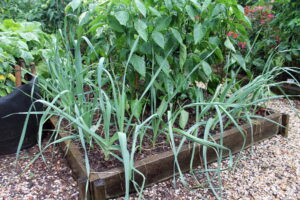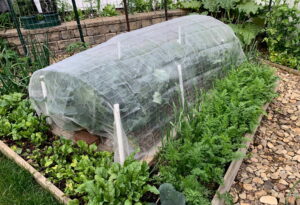The 8 Most Important Things I’ve Learned About Growing Vegetables
I’ve been growing home-garden vegetables in Pennsylvania for 44 years now, which I suppose qualifies me as a seasoned, old, compost-stained soil jockey.

Good soil and raised beds are the two most important pathways to veggie-gardening success.
Although I’ll admit I still can’t out-smart a groundhog or out-maneuver a deer, I have learned to circumvent many of the other obstacles that stand in the way of picking a peck of edible peppers.
Here are the eight lessons I think are most important…
Success starts (or ends) in the soil.
Hardly anyone has good soil, so success isn’t likely by just stripping off the grass and planting into virgin ground.
Vegetables are mostly annual plants that start from scratch each year and need loose, well drained soil for those fledgling roots to graduate into dinner. Our typical array of shale, red/yellow clay, and “builder’s soil” (subsoil topped with six inches of clay and shale following home-builder grading) doesn’t supply that.
To have a fighting chance, vegetables need deeply loosened soil (ideally a foot down) that’s thoroughly blended in a three-to-one or four-to-one ration with compost, rotted leaves, mushroom soil, aged cow manure, and/or similar organic matter.
Also important up-front is investing in a do-it-yourself, mail-in Penn State soil test kit to get a read on your soil’s pH (acidity level) and nutrition breakdown to determine what fertilizer and other amendments might be needed (if any).
Penn State soil test kits are available for $10 at county Extension offices, most garden centers, or online at Penn State’s soil-testing lab.
Raised beds are the way to go.
An even better way to deal with the aforementioned lousy soil situation is to construct planting boxes and fill them with compost-rich soil mixes, bypassing what’s underneath altogether.
Figure on at least six inches of depth (10 or 12 inches is better) if you’re going right on top the ground. A layer of cardboard, sections of newspaper, or similar decayable lining underneath will help kill off existing turfgrass and/or weeds.
It’s also fine to create a “hybrid” bed by both digging into the soil and then adding four to six additional raised inches of “good stuff.” Just be sure to mix everything together rather than creating distinctive layers.
Most people build boxes to contain the soil (stone, blocks, brick, recycled plastic timbers, or rot-resistant boards), but you can just mound up the beds without any edging.
Four-foot bed widths are ideal to let you reach in from both sides without ever having to walk on and compact your loose, fluffy soil.
Read George’s PennLive column on how to build and fill raised-bed gardens
Plant varieties make a huge difference.
Some particular varieties of each crop yield better, taste better, or fight off bugs and disease better than others. It pays to invest in the best performers to give yourself a genetic advantage right off the bat. Cheapie seeds are usually inferior.
Research varieties, compare notes with friends, or experiment until you find the ones that do best in your garden.
Or check out the list of my favorite all-time specific varieties for 24 different vegetables.
You gotta have good timing.
Just as in standup comedy, marriage-proposing, and parachute-opening, good timing is of utmost importance in the vegetable garden.

These are early-spring crops already up and thriving by early May.
Some crops need to go in the ground early so they mature before our weather gets too hot.
Other crops can’t go in the ground until all danger of frost is past or else they’ll turn into wilted green blobs overnight.
In other words, you can’t just plant whatever you want whenever you want.
Ideal timing varies by each year’s unfolding weather, but my PennLive post on when to plant which vegetables gives you an historical, plant-by-plant calendar.
Water can do you in or bail you out.
Soggy soil rots plant roots. Dry soil wilts plants to the point of no return. So it’s important to deliver just enough water. Rain hardly ever cooperates enough to get it right.
Raised beds pay off during monsoonish spells, and a handy hose dampens the soil before it goes bone dry. Your index finger is as good of a gauge as any to check on that.
Don’t wait for plants to wilt as your signal to water because stress (sometimes irreversible) is already occurring by then. Wilting means the time to water was yesterday.
When you water, it’s best to direct it right into the soil as opposed to over top of the leaves, which can encourage fungal diseases.
Drip irrigation lines are great for bigger gardens if you don’t mind the tradeoff of cost for time.
Empty space is your enemy.
Veggie-planting is not a once-and-done May thing.
Keep your vegetable garden as fully planted as humanly possible at all times – from the first peas of March until the last vestiges of kale left standing before snow buries it.
This not only denies weeds the chance to elbow their way into your awesome soil, it maximizes production.
As soon as you harvest one thing, put another one in. Example: replace radishes with peppers, cabbage with cucumbers, onions with beans.
Keep going right up until time runs out in fall for your second (or third) round to mature before cold temperatures and failing light put an end to it all.

Fencing is a must when growing vegetables. This fence features a sunken perimeter board and a buried apron extending a foot out.
Animals will show up.
Don’t lull yourself into thinking that you can grow vegetables unprotected out in the open. You might as well put up a fence right from the beginning… or be prepared to weep after one morning finding your crops gnawed to the ground by deer, groundhogs, rabbits, voles, and/or other four-legged furry feeders.
The best fence is buried a foot down and a foot out with at least three feet protecting upward. That stops burrowing and most climbing animals. If you let the top unsecured (i.e. wobbly), that’ll discourage groundhogs from getting up and over, as they can easily do on a tightly secured fence.
You might need to go up at least six or even eight feet to guard against deer – or extend your lower fence with another few feet of netting or with monofilament lines (tied with hanging ribbons or sachets of deer repellent).
Read George’s PennLive post on how to keep animals from eating your harvest
Failures are inevitable.
No matter how smart or experienced you become, plants will get spotted or brown, fail to thrive, and yes, even die.
As Murphy’s Law states, anything that can go wrong, will. (Murphy obviously was a gardener.)
So many things can short-circuit a plant – from bugs to disease to poor soil nutrition to wild and wacky weather – that it’s really a miracle that anything makes it to the table.
Don’t blame yourself when your garden doesn’t look anything like the ones in Martha Stewart’s magazines.
When something fails, try to figure out why and what you can/should do differently to head off a repeat next time.
Little by little, you’ll have fewer and fewer failures. You’ll never have a perfect garden, but at least you’ll be less of a loser.







